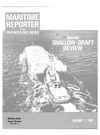
Page 36: of Maritime Reporter Magazine (January 1981)
Read this page in Pdf, Flash or Html5 edition of January 1981 Maritime Reporter Magazine
Technology Survey
Of Major U.S. Yards (continued from page 34) yard to use more advanced tech- nology would depend upon an economic feasibility analysis that takes into account the market and the characteristics of the in- dividual shipyard.
Survey Procedure
The evaluation system used for this technology survey was devel- oped by A&P Appledore Interna- tional, Ltd. (APA). The survey was conducted by Marine Equip- ment Leasing, Inc. (MEL).
The system for evaluating ship- building technology was first used in an extensive study prepared for the British Government. The purpose of the U.K. study was to obtain a commonly based, objec- tive appreciation of the quality and quantity of the hardware and the associated methods and tech- nology being used in each ship- yard. Since that time, the system has been formally applied in Can- ada, France, Egypt and India.
Information on the technology and methods employed in each shipyard is collected by way of a survey of these principal opera- tional categories:
A. Steelwork Production
B. Outfit Production and
Stores
The age! same
So what's the difference?
The pipe above obviously needs replacement, soonest possible, while the Kubota cargo oil pipe, shown below it, still has several years of good service life left. When replacing the pipe in your vessels, consider that Kubota's give more than two times longer service than most others. Fifteen years of use without replacement is ample proof of their superiority. Why?
Kubota materials and methods cannot be found anywhere else in the world. The material is KCP-3L, a chrome manganese steel especially developed by this company. It is made by Kubota's exclusive centrifugal casting techniques, widely acknowledged to be of the highest technological level. The highest degree of weldability gives it the greatest facility of use. That is why fully 95% of all Japanese tankers use Kubota cargo oil pipe. And why shipbuilders and repair docks around the world keep it on hand for installation and replacement. Write today for full information on how to raise the efficiency of your tanker operations.
The Basic Necessities Giant
KIIBOTK MRGO OIL PIPE
Osaka Head Olfice: 2-47, Shikit Suhigashi 1-Chome, Naniwa-ku, Osaka 556-91, Japan
Cable Address IRONKUBOTA OSAKA Telex 526-7785 KUBOTA J Phone: Osaka 648-2168
Tokyo Olfice: 3 Nihonbashi Muromachi 3-chome Chuo-ku. Tokyo Japan
Cable Address IRONKUBOTA TOKYO Telex 222-6068 KUBOTA J Phone Tokyo 279-21 11
Overseas Offices: —
Kubota, Ltd.. New York 0tfice:50 Rockefeller Plaza, Suite 1214, New York. NY 10020. U S A Phone: 212-246-4871.Telex 7105816020 KUBOTA NYK Cable Address KUBOTA NYO
Kubota America Corporation: 523 West Sixth Street. Suite 1113, Los Angeles. California 90014 USA Phone 213-627-6377 Telex 673238 KUBOTA LSA
Kubota, Ltd., London Office: 11/12 Hanover Street, London WIR 9HF, U K Phone 01-629-6471 4 Telex 263235 KUBOTA G
Kubota, Ltd.. Dusseldorf Office: 4000 Ousseldorf, Georg-Glock-Strasse. 14 Federal Republic of Germany Phone 0211-450-907 Telex 8584498 KBTA D Cable Address KBTA-D
Kubota, Ltd., Athens Office: 20, 28th of October Street, Filothei, Athens Greece Phone 6825646 Telex 214227 EXSE GR. 216343 EXSE GR
Representative of Kubota Ltd (Jakarta Office): Skyline Building 8F JL MH Thamrin No 9 Indonesia Phone 363977 Telex 73-46630 KUBOTA JKT
Write 235 on Reader Service Card 36
C. Other Pre-erection Activi- ties
D. Ship Construction and Out- fit Installation
E. Layout and Materials Han- dling
F. Environment and Amenities
G. Design, Drafting, Produc- tion Engineering and
Lofting
H. Organization and Operating
Systems
These categories in turn have been broken down into 70 ele- ments. Each of the 70 elements covers a discrete shipbuilding op- eration or procedure.
A descriptive set of standards for each of the 70 elements was prepared. These standards con- sist of examples of methods and practices which typify each of four levels of technology for each element. The surveyor is thereby able to assign a "level of tech- nology" to each aspect of ship- yard operation which is studied.
During the survey, the "closest" whole level number is marked and comments peculiar to the ship- yard and element being studied are recorded.
The selection of the U.S. ship- yards to be surveyed was based primarily on size, employment and product. Since the survey in- cluded foreign shipyards building primarily for deepsea commercial service with some naval construc- tion, the largest of the U.S. ship- yards building for this service were selected. These shipyards are now building over a broad span of complexity and ship size, from a nuclear-powered aircraft carrier and submarines to gas turbine-powered frigates and from commercial ships ranging from a 10,000-dwt tanker to 395,- 000-dwt ultralarge crude carriers (ULCCs) and liquefied natural gas (LNG) ships.
In order to survey 13 U.S. ship- yards in the allotted time, two survey teams were required. The earlier surveys of foreign ship- yards also involved different sur- veyors. All surveyors, however, used the same standards and es- sentially the same survey tech- niques. Several steps were taken to assure consistency of survey results.
First, during the week of June 5, 1978, two senior members of the APA staff conducted a work- shop for the six MEL surveyors on survey content and procedure.
The workshop covered in detail what was included in each of the 70 elements and a discussion of the four technology levels for each element. This workshop and the ensuing exchange of views enabled the U.S. surveyors to be on the same "wavelength" as their British counterparts.
The second step taken by MEL to assure consistency and com- parability of data was to design data sheets for collecting data.
The third step took place after (continued on page 38)
Write 311 on Reader Service Card •
Maritime Reporter/Engineering News

 35
35

 37
37
